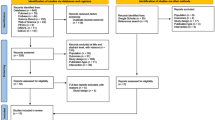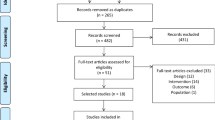Abstract
Several studies have examined the effect of different types of exercise on people with fibromyalgia. The aim of this study was to identify which dosage of resistance training is effective to reduce pain in women with fibromyalgia. Two authors independently selected studies included in a Cochrane Systematic Review and from an updated search up to May 2021 using the following databases: Embase, Central, Lilacs, PEDro, Current Controlled Trials, and WHO International Clinical Trials Registry Platform, Scopus and ISI Web of Science. Inclusion criteria were randomized clinical trials (RCTs) with female patients (18 years of age or older) diagnosed with fibromyalgia according to the American College of Rheumatology (ACR) criteria and the intervention, resistance exercises for pain reduction. The pain outcome value was extracted from studies for meta-analysis. Nine RCTs were included. Compared to the control groups, resistance exercise groups demonstrated a clinically and statistically significant effect on pain reduction when each exercise was performed in 1–2 sets or 3–5 sets of 4–12 or 5–20 repetitions twice a week, for 8–12 weeks, at intensities of 40–80% with one repetition maximum or perceived exertion. Resistance training exercises are effective to reduce pain in women with fibromyalgia when performed at moderate-to-high intensity in 1–2 sets of 4–20 repetitions twice a week, for 8–12 weeks. The protocol was registered on the International Prospective Register of Systematic Reviews (PROSPERO) platform, CRD42018095205.









Similar content being viewed by others
Availability of data and material
The authors confirm that the data supporting the findings of this study are available within the article and its supplementary materials.
References
Macfarlane GJ, Kronisch C, Dean LE et al (2017) EULAR revised recommendations for the management of fibromyalgia. Ann Rheum Dis 76:318–328. https://doi.org/10.1136/annrheumdis-2016-209724
Heymann RE, Paiva ES, Martinez JE et al (2017) New guidelines for the diagnosis of fibromyalgia. Rev Bras Reumatol 57:S467–S476. https://doi.org/10.1016/j.rbre.2017.07.002
Martinez JE, Paiva ES, Rezende MC et al (2017) EpiFibro (Brazilian Fibromyalgia Registry): data on the ACR classification and diagnostic preliminary criteria fulfillment and the follow-up evaluation. Rev Bras Reumatol 57:129–133. https://doi.org/10.1016/j.rbre.2016.09.012
Avila LA, Araujo Filho GM, Guimarães EFU, Gonçalves LCS, Paschoalin PN, Aleixo FB (2014) Characterization of the pain, sleep and alexithymia patterns of patients with fibromyalgia treated in a Brazilian tertiary center. Rev Bras Reumatol 54:409–413. https://doi.org/10.1016/j.rbr.2014.03.017
Freitas RPA, Andrade SC, Spyrides MHC, Micussi MTABC, Sousa MBC (2017) Impacts of social support on symptoms in Brazilian women with fibromyalgia. Rev Bras Reumatol 57:197–203. https://doi.org/10.1016/j.rbre.2016.07.001
Geneen LJ, Moore RA, Clarke C, Martin D, Colvin LA, Smith BH (2017) Physical activity and exercise for chronic pain in adults: an overview of Cochrane Reviews. Cochrane Database Syst Rev 1:1CD011279. https://doi.org/10.1002/14651858.cd011279.pub3
Andrade A, Vilarino GT, Bevilacqua GG (2017) What is the effect of strength training on pain and sleep in patients with fibromyalgia? Am J Phys Med Rehabil 96:889–893. https://doi.org/10.1097/phm.0000000000000782
Busch AJ, Webber SC, Richards RS et al (2013) Resistance exercise training for fibromyalgia. Cochrane Database Syst Rev Issue 12:CD010884. https://doi.org/10.1002/14651858.cd010884
Carvalho APV, Silva V, Grande AJ (2013) Assessment of risk of bias in randomized controlled trials by the Cochrane collaboration tool. Diagn Trat 18:38–44
Ferguson B (2014) ACSM’s guidelines for exercise testing and prescription, 9th edn. J Can Chiropr Assoc 58:328
Review Manager (RevMan) [Computer program]. Version 5.3. Copenhagen: The Nordic Cochrane Centre, The Cochrane Collaboration; 2014
Higgins JPT, Thomas J, Chandler J et al (2019) Cochrane handbook for systematic reviews of interventions. Wiley, Chichester
Brasil. Ministério da Saúde. Secretaria de Ciência, Tecnologia e Insumos Estratégicos. Departamento de Ciência e Tecnologia (2012) Diretrizes metodológicas: elaboração de revisão sistemática e metanálise de ensaios clínicos randomizados. Editora do Ministério da Saúde, Brasília, Brazil.
Häkkinen A, Häkkinen K, Hannonen P, Alen M (2001) Strength training induced adaptations in neuromuscular function of premenopausal women with fibromyalgia: comparison with healthy women. Ann Rheum Dis 60:21–26. https://doi.org/10.1136/ard.60.1.21
Jones KD, Burckhardt CS, Clark SR, Bennett RM, Potempa KM (2002) A randomized controlled trial of muscle strengthening versus flexibility training in fibromyalgia. J Rheumatol 29:1041–1048
Valkeinen H, Alen M, Hannonen P, Hakkinen A, Airaksinen O, Häkkinen K (2004) Changes in knee extension and flexion force, EMG and functional capacity during strength training in older females with fibromyalgia and healthy controls. Rheumatology 43:225–228. https://doi.org/10.1093/rheumatology/keh027
Assumpção A, Matsutani LA, Yuan SL, Santo AS, Sauer J, Mango P, Marques AP (2018) Muscle stretching exercises and resistance training in fibromyalgia: which is better? A three-arm randomized controlled trial. Eur J Phys Rehabil Med 54:663–670. https://doi.org/10.23736/S1973-9087.17.04876-6
Glasgow A, Stone TM, Kingsley JD (2017) Resistance exercise training on disease impact, pain catastrophizing and autonomic modulation in women with fibromyalgia. Int J Exerc Sci 10:1184–1195
Larsson A, Palstam A, Löfgren M et al (2015) Resistance exercise improves muscle strength, health status and pain intensity in fibromyalgia—a randomized controlled trial. Arthritis Res Ther 17:161. https://doi.org/10.1186/s13075-015-0679-1
Gavi MBRO, Vassalo DV, Amaral FT, Macedo DCF, Gava PL, Dantas EM, Valim V (2014) Strengthening exercises improve symptoms and quality of life but do not change autonomic modulation in fibromyalgia: a randomized clinical trial. PLoS ONE 3:e90767. https://doi.org/10.1371/journal.pone.0090767
Kingsley JD, Panton LB, Toole T, Sirithienthad P, Mathis R, McMillan V (2005) The effects of a 12-week strength-training program on strength and functionality in women with fibromyalgia. Arch Phys Med Rehabil 86:1713–1721. https://doi.org/10.1016/j.apmr.2005.04.014
Silva HJA, Assunção Júnior JC, de Oliveira FS, Oliveira JMP, Dantas GAF, Lins CAA, Souza MC (2018) Sophrology versus resistance training for treatment women with fibromyalgia: a randomized controlled trial. J Bodyw Mov Ther 23:382–389. https://doi.org/10.1016/j.jbmt.2018.02.005
Bircan C, Karasel SA, Akgun B, El O, Alper S (2008) Effects of muscle strengthening versus aerobic exercise program in fibromyalgia. Rheumatol Int 28:527–532. https://doi.org/10.1007/s00296-007-0484-5
Kayo AH, Peccin MS, Sanches CM, Trevisani VFM (2011) Effectiveness of physical activity in reducing pain in patients with fibromyalgia: a blinded randomized clinical trial. Rheumatol Int 32:2285–2292. https://doi.org/10.1007/s00296-011-1958-z
Meyer BB, Lemley KJ (2000) Utilizing exercise to affect the symptomatology of fibromyalgia: a pilot study. Med Sci Sports Exerc 32:1691–1697. https://doi.org/10.1097/00005768-200010000-00005
Andrade A, Steffens RAK, Sieczkowska SM, Tartaruga LAP, Vilarino GT (2018) A systematic review of the effects of strength training in patients with fibromyalgia: clinical outcomes and design considerations. Adv Rheumatol 58:36. https://doi.org/10.1186/s42358-018-0033-9
Acknowledgements
We would like to acknowledge the authors of the Busch's Cochrane SR (2013) who provided their systematic search and shared the references of their included RCTs.
Funding
The authors received financial support from Fundação de Ensino e Pesquisa em Ciências da Saúde (Fepecs), number: No. 00064-0000417/2018-52.
Author information
Authors and Affiliations
Contributions
JMS: substantial contributions to the conception or design of the work; or the acquisition, analysis, or interpretation of data for the work; drafting the work or revising it critically for important intellectual content; final approval of the version to be published; agreement to be accountable for all aspects of the work in ensuring that questions related to the accuracy or integrity of any part of the work are appropriately investigated and resolved. BSB: substantial contributions to the conception or design of the work; or the acquisition, analysis, or interpretation of data for the work; drafting the work or revising it critically for important intellectual content; final approval of the version to be published; agreement to be accountable for all aspects of the work in ensuring that questions related to the accuracy or integrity of any part of the work are appropriately investigated and resolved. GJA: substantial contributions to the conception or design of the work; or the acquisition, analysis, or interpretation of data for the work; drafting the work or revising it critically for important intellectual content; final approval of the version to be published; agreement to be accountable for all aspects of the work in ensuring that questions related to the accuracy or integrity of any part of the work are appropriately investigated and resolved. JO: substantial contributions to the conception or design of the work; or the acquisition, analysis, or interpretation of data for the work; drafting the work or revising it critically for important intellectual content; final approval of the version to be published; agreement to be accountable for all aspects of the work in ensuring that questions related to the accuracy or integrity of any part of the work are appropriately investigated and resolved. AMI: substantial contributions to the conception or design of the work; or the acquisition, analysis, or interpretation of data for the work; drafting the work or revising it critically for important intellectual content; final approval of the version to be published; agreement to be accountable for all aspects of the work in ensuring that questions related to the accuracy or integrity of any part of the work are appropriately investigated and resolved.
Corresponding author
Ethics declarations
Conflict of interest
The authors declared no potential conflicts of interest with respect to the research, authorship, and/or publication of this article.
Ethics approval
This article does not contain any studies with human participants or animals performed by any of the authors.
Additional information
Publisher's Note
Springer Nature remains neutral with regard to jurisdictional claims in published maps and institutional affiliations.
Supplementary Information
Below is the link to the electronic supplementary material.
Rights and permissions
About this article
Cite this article
da Silva, J.M., de Barros, B.S., Almeida, G.J. et al. Dosage of resistance exercises in fibromyalgia: evidence synthesis for a systematic literature review up-date and meta-analysis. Rheumatol Int 42, 413–429 (2022). https://doi.org/10.1007/s00296-021-05025-9
Received:
Accepted:
Published:
Issue Date:
DOI: https://doi.org/10.1007/s00296-021-05025-9




